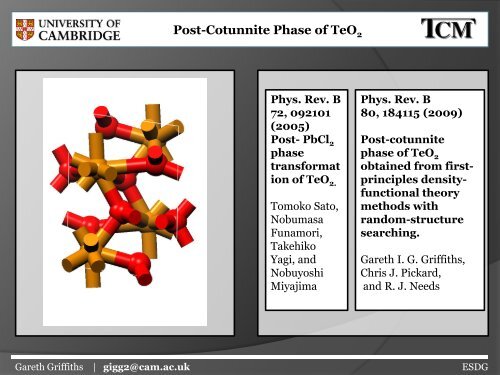slides - University of Cambridge
slides - University of Cambridge
slides - University of Cambridge
Create successful ePaper yourself
Turn your PDF publications into a flip-book with our unique Google optimized e-Paper software.
Post-Cotunnite Phase <strong>of</strong> TeO 2<br />
Phys. Rev. B<br />
72, 092101<br />
(2005)<br />
Post- PbCl 2<br />
phase<br />
transformat<br />
ion <strong>of</strong> TeO 2.<br />
Tomoko Sato,<br />
Nobumasa<br />
Funamori,<br />
Takehiko<br />
Yagi, and<br />
Nobuyoshi<br />
Miyajima<br />
Phys. Rev. B<br />
80, 184115 (2009)<br />
Post-cotunnite<br />
phase <strong>of</strong> TeO 2<br />
obtained from firstprinciples<br />
densityfunctional<br />
theory<br />
methods with<br />
random-structure<br />
searching.<br />
Gareth I. G. Griffiths,<br />
Chris J. Pickard,<br />
and R. J. Needs<br />
Gareth Griffiths | gigg2@cam.ac.uk<br />
ESDG
The Problem / motivation<br />
Cotunnite (PbCl 2 ) structure<br />
TiO 2 ZrO 2 HfO 2 CeO 2 PbO 2<br />
PuO 2 UO 2 TeO 2 ThO 2<br />
Predicted SiO 2 @ 690 Gpa<br />
CN=9 CN=10 as reported for<br />
dihalides, with increased pressure?<br />
TeO 2 used for nonlinear optical<br />
devices, potentially from nanocrystals.<br />
Gareth Griffiths | gigg2@cam.ac.uk<br />
ESDG
Random Structure Searching<br />
Randomly throw<br />
atoms into a<br />
randomly shaped<br />
unit cell<br />
Relax the system as far<br />
as possible<br />
Calculate system enthalpy<br />
& then repeat to find many<br />
more candidate structures<br />
Fiddle about with the<br />
lowest enthalpy / most<br />
interesting structures<br />
“One <strong>of</strong> the continuing scandals<br />
in the physical sciences is that it<br />
remains in general impossible to<br />
predict the structure <strong>of</strong> even the<br />
simplest crystalline solids from a<br />
knowledge <strong>of</strong> their chemical<br />
composition.”<br />
J. Maddox Nature 335,<br />
201(1988)<br />
SYMMOPS (2,3,4,6,8)<br />
MOLECULES<br />
MINSEP<br />
Gareth Griffiths | gigg2@cam.ac.uk<br />
ESDG
Searching & the Structures<br />
The searches:<br />
~1800 relaxed structures in total<br />
Unconstrained 2 units<br />
Unconstrained 4 units<br />
1 unit * 3 symmetry ops.<br />
1 unit * 4 symmetry ops.<br />
1 unit * 6 symmetry ops.<br />
1 unit * 8 symmetry ops.<br />
150 GPa<br />
1 * 120º molecule * 4 symmetry ops.<br />
2 * 120º molecules * 4 symmetry ops.<br />
3 * 120º molecules * 4 symmetry ops.<br />
1 * 120º molecule * 4 symmetry ops.<br />
3* 120º molecules * 2 symmetry ops.<br />
4* 120º molecules * 2 symmetry ops.<br />
280 GPa<br />
Gareth Griffiths | gigg2@cam.ac.uk<br />
ESDG
Convergence / Pseudopotentials<br />
Pseudopotentials<br />
All results use the standard<br />
CASTEP On The Fly Oxygen and<br />
Te pseudopotentials.<br />
Standard Te_OTF.usp treats the<br />
5s and 5p orbitals explicitly.<br />
Tested (both further relaxation<br />
and searching) with an OTF Te<br />
pseudopotential that treated the<br />
4d, 5s and 5p orbitals explicitly,<br />
for which results were<br />
essentially unchanged.<br />
Convergence<br />
Searching:<br />
490 eV plane wave cut<strong>of</strong>f<br />
2π 0.07 Å -1 MP grid spacing.<br />
Polishing / refinement:<br />
800 eV plane wave cut<strong>of</strong>f<br />
2π 0.03 Å -1 MP grid spacing.<br />
Enthalpy difference between<br />
Cotunnite and Post-cotunnite<br />
structures at 130 Gpa changed<br />
by less than 0.0001 eV per TeO2<br />
unit upon doubling the plane<br />
wave cut<strong>of</strong>f & no# <strong>of</strong> kpoints.<br />
Gareth Griffiths | gigg2@cam.ac.uk<br />
ESDG
Enthalpy vs Pressure<br />
“Double & Shake” !<br />
Gareth Griffiths | gigg2@cam.ac.uk<br />
ESDG
Bulk Modulus<br />
Experiment (Sato) Cotunnite<br />
over 30-70 Gpa with K' 0 =4<br />
K 0 =115±17 Gpa<br />
V 0 =152.8Å 3<br />
Calculated Cotunnite 30-70 Gpa<br />
K 0 =119 Gpa<br />
V 0 =155.3Å 3<br />
K' 0 =4.43<br />
Calculated Cotunnite 0-16 Gpa<br />
K 0 =46.5 Gpa<br />
V 0 =170.9Å 3<br />
K' 0 =5.35<br />
Calculated P2 1 /m 125-200 Gpa<br />
K 0 =114 Gpa<br />
V 0 =152.4Å 3<br />
K' 0 =4.6<br />
Gareth Griffiths | gigg2@cam.ac.uk<br />
ESDG
X-ray diffraction<br />
Gareth Griffiths | gigg2@cam.ac.uk<br />
ESDG
X-ray diffraction<br />
Gareth Griffiths | gigg2@cam.ac.uk<br />
ESDG
Cotunnite volume ‘kink’<br />
Gareth Griffiths | gigg2@cam.ac.uk<br />
ESDG
Band Structure<br />
Gareth Griffiths | gigg2@cam.ac.uk<br />
ESDG
Band Gaps<br />
Gareth Griffiths | gigg2@cam.ac.uk<br />
ESDG
Summary / Conclusions<br />
•Study supports experimental observation<br />
<strong>of</strong> post-cotunnite phase at pressures<br />
accessible to a diamond anvil cell.<br />
•Predict transition to P2 1 /m phase at 130<br />
Gpa.<br />
•New P2 1 /m phase does not appear to be<br />
a general post-cotunnite phase<br />
(shame...TiO 2 !)<br />
•Cotunnite re-enters at 260 Gpa<br />
•Higher quality x-ray diffraction data<br />
required to confirm.<br />
Gareth Griffiths | gigg2@cam.ac.uk<br />
ESDG
Acknowledgments<br />
This work was performed using the<br />
Darwin Supercomputer <strong>of</strong> the<br />
<strong>University</strong> <strong>of</strong> <strong>Cambridge</strong> High<br />
Performance Computing Service<br />
(http://www.hpc.cam.ac.uk/),<br />
provided by Dell Inc. using Strategic<br />
Research Infrastructure Funding<br />
from the Higher Education Funding<br />
Council for England.<br />
Gareth Griffiths | gigg2@cam.ac.uk<br />
ESDG

















